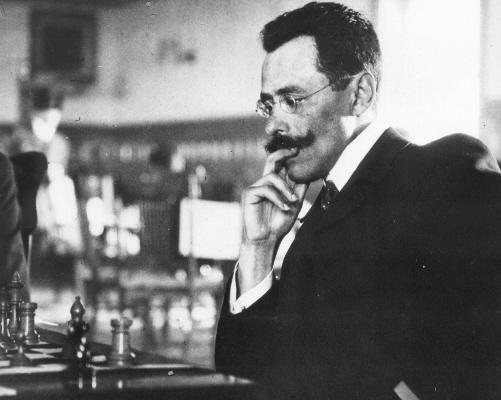
Edward Winter

Dawid Janowsky (1868-1927)
‘Even at New York, 1924, the masters agreed that for the first four hours of play Janowsky was equal to any player in the world.’ So declared the obituary of Janowsky on pages 28-30 of the February 1927 American Chess Bulletin, which also stated that around the first few years of the century he ‘was the strongest player in the world’. Without going that far, Capablanca wrote in My Chess Career that Janowsky had been ‘one of the most feared of all the players’. In Diario de la Marina of 20 April 1913 the Cuban mentioned that Janowsky’s best period was ‘around 1902’.
Ossip Bernstein gave the following assessment on page 15 of the January 1956 Chess Review:
‘Janowsky was no chess scientist or theoretician. He knew what he had to do on the chessboard; but he did not know, or could not explain, why it had to be done. He had only two rules in chess: always attack; always get the two bishops (and, indeed, he used the advantage of the two bishops wonderfully). His main strength, indeed, was his extraordinary intuition, which gave him the exact feeling for what to do and how to do it.’
The didactic value of Janowsky’s handling of the bishop pair was also stressed by Alekhine. Writing in 1945, he noted that the prodigy Arturo Pomar had not yet learned the value of the two bishops and advised that ‘it would be very profitable for him to study the best games of Janowsky’. (Source ¡Legado! by Alekhine, page 125.)
A prime characteristic of Janowsky’s playing style was its sheer energy, not to say restlessness. Little more than 20% of his tournament and match games were drawn. ‘Il n’est pas dans mon tempérament d’attendre’, he once declared (BCM, June 1909, page 261). His temperament has, in fact, attracted far more attention than his games or results yet he was, for instance, the only master apart from Tarrasch to beat the first four world champions, Steinitz, Lasker, Capablanca and Alekhine. In all, he scored a dozen victories against them. Today, few brilliancies from his long career are kept alive, and only one book has been devoted to him, published in Russian in 1987. [See the Afterword below.] His country of origin (Poland) has done no more for his memory than have his adopted homelands (France and the United States).
Dawid Markelowicz Janowsky (born 1868) was the last of the unsuccessful challengers for Lasker’s world championship title (Berlin, November-December 1910, a severe defeat). It is, or should be, well known that the two players’ ten-game match in Paris the previous year had not been for the world title, contrary to the assertions of such historical analphabets as Jonathan Speelman (The Observer of 19 April 1998). In that same article Speelman gave a position from a familiar game in the match, and wrote, ‘I had never seen it before’. The position was incorrect.
There follow some neglected Janowsky combinations from off-hand play:

From a knight’s odds game between D. Janowsky and S. David, Paris, 1891 or 1892. 19 Bxg7+ Kxg7 20 Rxh7+ Kxh7 21 f6+ Kh8 22 Qh5+ and mate in two.
Source: Deutsche Schachzeitung, February 1892, pages 50-51.
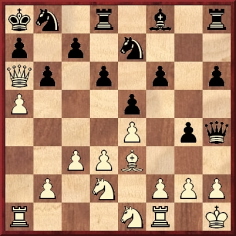
Janowsky v N.N., Paris, 1892
Play went: 16 Qxa7+ Kxa7 17 axb6+ Kb7 18 Ra7+ Kc6 19 Rxc7+ Kb5 20 Nc2 (20 c4+ would have saved a move.) 20…Nec6 21 c4+ Ka6 22 Ra1+ Na5 23 Nb4 mate.
Source: Deutsche Schachzeitung, May 1892, page 152.
The position below is also from a Paris game, which Janowsky (White) played blindfold:

1 Nxg6 Qxg6 2 Bxf5 Qxf5 3 Qxg8+ Bxg8 4 Rxe7+ Kf8 5 Rxd8 mate.
Source: Deutsche Schachzeitung, November 1893, page 345.
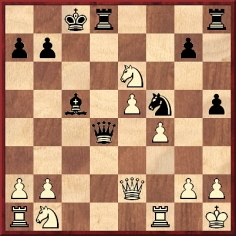
Friedman v Janowsky, Paris, 1894
1…h4 2 Nxd4 Ng3+ 3 hxg3 hxg3+ 4 Kg1 Bxd4+ 5 Rf2 Bxf2+ 6 Qxf2 Rd1+ 7 Qf1 Rh1+ 8 Kxh1 Rxf1 mate.
Source: BCM, September 1894, page 355 and November 1894, page 452.

Dawid Janowsky

Robino v Janowsky, Paris
1…Bf5 2 Nxf5 Qd2+ 3 Kb1 Qd1+ 4 Bc1 Qxc1+ 5 Kxc1 Ba3+ 6 Kb1 Rd1 mate.
Source: La Stratégie, 15 April 1898, page 118.

Coulomzine v Janowsky, Paris
29…Rg6 30 Kh2 Nd2 31 Rg1 e2 32 Qxd8+ Qxd8 33 Rxd2 Qxd2 34 Nxd2 Rxg2+ 35 Rxg2 e1(Q) 36 Re2 Qh1+ 37 Kg3 Qg1+ 38 Kh4 g5+ 39 Kh5 gxf4 40 Re5 and Black mated in three moves.
Source: La Stratégie, 15 November 1898, page 344. Typically complex Janowsky play, although various short-cuts would have been possible (31…Rxg2+, 33…Qh4 and 39…Qg3).
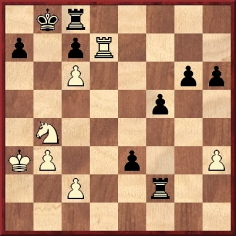
Janowsky was White in this position from a game at the Manhattan Chess Club, New York. He played 1 Na6+ Ka8 2 Nxc7+ Kb8 3 Na6+ Ka8 4 Rb7 e2 5 Rb8+ Rxb8 6 Nc7 mate.
Source: American Chess Bulletin, March 1918, page 69.

Dawid Janowsky
A specimen of his play in a consultation game:
Dawid Janowsky – Herbert Edward
Dobell, Mackeson and Watt
Hastings, 1 September 1897
Ruy
López
1 e4 e5 2 Nf3 Nc6 3 Bb5 Nf6 4 O-O Nxe4 5 Re1 Nd6 6 Nxe5 Be7 7 Bd3 Nxe5 8 Rxe5 O-O 9 Nc3 Bf6 10 Re3 g6 11 b3 Ne8 12 Ba3 d6 13 Nd5 Bg5 14 f4 Bh6 15 Bb2 Be6 16 Qf3 c6 17 Nc3 d5

18 f5 d4 19 fxe6 fxe6 20 Qh3 Bxe3+ 21 dxe3 dxc3 22 Qxe6+ Kh8 23 Bxc3+ Ng7 24 Rd1 Qe8 25 Qh3 Rd8 26 Qh6 Rd7 27 h3 b5 28 Rd2 Kg8 29 e4 Qe7 30 Kh1 Qc5 31 Bb2 Nh5 32 Kh2 Rdf7 33 Be2 Nf4 34 Bg4 Qb4 35 Rd4 Qe1 36 Rd7 Rxd7 37 Bxd7 Rf7 38 Be8 Qxe4 39 Bxf7+ Kxf7 40 Qxh7+ Ke8 41 Qh8+ Kd7 42 Qd4+ Qxd4 43 Bxd4 a6 44 g4 Ke6 45 h4 and White won.
Source: BCM, October 1897, pages 395-396. Janowsky played four games simultaneously against teams of three players.
Now a sample of Janowsky’s annotations to one of his games:
Georg Marco – Dawid Janowsky
Sixth match game, S.S. Pretoria, 13 June 1904
King’s
Gambit Declined
1 e4 e5 2 f4 Bc5 3 Qf3 (An innovation meriting consideration. [In fact, 3 Qf3 was played twice by Charousek in 1896, against Showalter and Maróczy.]) 3…Nc6 4 c3 d6 5 Bc4 Nf6 (5…Be6 was stronger.) 6 d3 O-O (Premature, in view of the ease with which White sets up a king’s side attack. Here too 6…Be6 would be much better.) 7 f5 (Hemming in the enemy queen’s bishop and threatening g4, followed by h4.) 7…d5 8 Bb3! (8 Bxd5 Nxd5 9 exd5 Ne7 10 g4 Qxd5, etc. and 8 exd5 e4 9 dxe4 Ne5 10 Qe2 Nxc4 11 Qxc4 Nxe4, etc. would be to White’s disadvantage.) 8…dxe4 9 dxe4 Qd6 10 Bg5 (With 10 g4 he could have put his opponent in a very tricky position.) 10…h6 11 Bxf6 (The reply to 11 Bh4 would have been 11…Rd8.) 11…Qxf6 12 Nd2 Rd8 (Taking possession of the open file and having in mind the possibility of being able, if necessary later on, to escape with the king via f8 and e7.) 13 O-O-O a5 (To set up a counter-attack and chase the bishop away from the very awkward diagonal which it occupies.) 14 h4 (In positions of this kind there is rarely time to defend, and victory goes to the player who can attack the fastest.) 14…a4 15 Bc2 b5 16 Ne2 b4 17 g4 bxc3 (Too soon. 17…Ba6, threatening 18…Bxe2, followed by 19…bxc3, would have been much stronger.) 18 Nxc3 (Forced, for if 18 bxc3 then 18…Ba3+, etc.) 18…Nd4 19 Qg2 a3 20 g5 (20 b3 would be more solid.) 20…axb2+ 21 Kb1 Qc6 22 gxh6 (He has no time to play 22 f6 because of 22…Bb4.) 22…Qxh6 23 Nb3 Ba3 24 Nb5 (A tempting move, the consequences of which White did not examine sufficiently closely.)
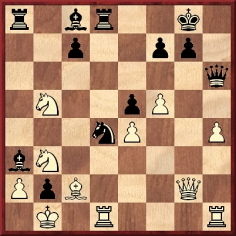
24…Nxb5 (The attack he obtains provides ample compensation for the sacrifice of the exchange.) 25 Rxd8+ Kh7 26 Rd3 (If 26 Qg3 then 26…Rb8, threatening mate in a few moves by 27…Qc1+. After 27 R8d1, Black wins with 27…Qc6.) 26…Rb8 27 Qg5 (He was threatened with 27…Qc1+ 28 Rxc1 bxc1(Q)+ 29 Nxc1 Nc3+ and mate next move.) 27…Ba6 28 Nd2 Bc5 29 Rhh3 Nd4 30 Rb3 (After 30 Rdg3 Bb4 31 Nb3 Nxc2 32 Kxc2 c5 the loss of a piece is inevitable.) 30…Nxb3 31 Bxb3 f6 32 Qxh6+ (If 32 Qg2 then 32…Bb4, etc.) 32…Kxh6 33 Kxb2 (Material is now level, but Black has the better pawns, two bishops and a superior position.) 33…Rd8 (Decisive.) 34 Kc2 (If 34 Nf3 Kh5, etc., and if 34 Nc4 Rd4, etc.) 34…Bb4 35 Nb1 Bb7 36 Resigns. (His e-, f- and h-pawns cannot be defended.)
Source: La Stratégie, 21 September 1904, pages 263-264.

Dawid Janowsky
Janowsky was active in chess play until the end. An onlooker at the 1925 Marienbad tournament wrote on page 295 of the July 1925 BCM: ‘Janowsky, gaunt, cadaverous, but with a ready smile which lights up his whole face, goes up to the two or three ladies who sit there waiting, and makes one of his many little witticisms about the other players. “Have you seen so and so? He sway to and fro, to and fro. If he do it much more, I tell him he make me sea-sick”.’
At Semmering, 1926 Janowsky was still winning remarkable games, including one against Rubinstein. He died on 15 January 1927 in Hyères (France). The Wiener Schachzeitung (February 1927, page 30) described him as ‘one of the greatest masters of the royal game’. Page 191 of Ludwig Bachmann’s Schachjahrbuch 1927 called him a genius. The obituary writer in L’Echiquier (January 1927, page 552), who had seen him a few months previously in Ghent, reported on the ‘sunken eyes behind large spectacles’ of a master who had been ‘one of the greatest players of his time’. John Keeble noted on pages 103-104 of the March 1927 BCM that Janowsky had arrived in Hyères in December 1926 for a tournament due to begin there the following month. He was diagnosed as being in the final stage of tuberculosis. In Keeble’s words, Janowsky ‘was absolutely without means and in a dying state. A lonely man (he had never married), no relatives near to him, no religion, no income and apparently no friends, for he was not really a sociable man to make them. What a sad end to a successful career devoted almost wholly to chess.’
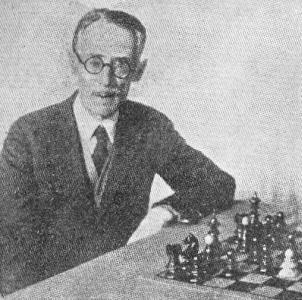
Dawid Janowsky
As mentioned in C.N. 3897, a large monograph in German was published in 2005, Vabanque Dawid Janowsky 1868-1927 by Daniel Ackermann:

To the Chess Notes main page.
To the Archives for other feature articles.
Copyright 2007 Edward Winter. All rights reserved.